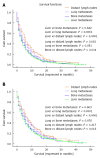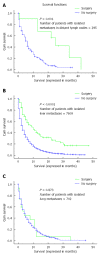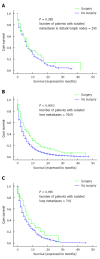Prognostic value of site-specific metastases in pancreatic adenocarcinoma: A Surveillance Epidemiology and End Results database analysis
- PMID: 28348494
- PMCID: PMC5352929
- DOI: 10.3748/wjg.v23.i10.1872
Prognostic value of site-specific metastases in pancreatic adenocarcinoma: A Surveillance Epidemiology and End Results database analysis
Abstract
Aim: To evaluate the prognostic value of site-specific metastases among patients with metastatic pancreatic carcinoma registered within the Surveillance, Epidemiology and End Results (SEER) database.
Methods: SEER database (2010-2013) has been queried through SEER*Stat program to determine the presentation, treatment outcomes and prognostic outcomes of metastatic pancreatic adenocarcinoma according to the site of metastasis. In this study, metastatic pancreatic adenocarcinoma patients were classified according to the site of metastases (liver, lung, bone, brain and distant lymph nodes). We utilized chi-square test to compare the clinicopathological characteristics among different sites of metastases. We used Kaplan-Meier analysis and log-rank testing for survival comparisons. We employed Cox proportional model to perform multivariate analyses of the patient population; and accordingly hazard ratios with corresponding 95%CI were generated. Statistical significance was considered if a two-tailed P value < 0.05 was achieved.
Results: A total of 13233 patients with stage IV pancreatic cancer and known sites of distant metastases were identified in the period from 2010-2013 and they were included into the current analysis. Patients with isolated distant nodal involvement or lung metastases have better overall and pancreatic cancer-specific survival compared to patients with isolated liver metastases (for overall survival: lung vs liver metastases: P < 0.0001; distant nodal vs liver metastases: P < 0.0001) (for pancreatic cancer-specific survival: lung vs liver metastases: P < 0.0001; distant nodal vs liver metastases: P < 0.0001). Multivariate analysis revealed that age < 65 years, white race, being married, female gender; surgery to the primary tumor and surgery to the metastatic disease were associated with better overall survival and pancreatic cancer-specific survival.
Conclusion: Pancreatic adenocarcinoma patients with isolated liver metastases have worse outcomes compared to patients with isolated lung or distant nodal metastases. Further research is needed to identify the highly selected subset of patients who may benefit from local treatment of the primary tumor and/or metastatic disease.
Keywords: Bone metastases; Liver metastases; Lung metastases; Pancreatic cancer; Surveillance Epidemiology and End Results database.
Conflict of interest statement
Conflict-of-interest statement: The authors declare they have no conflicts of interest.
Figures



References
-
- Ma J, Jemal A. The rise and fall of cancer mortality in the USA: why does pancreatic cancer not follow the trend? Future Oncol. 2013;9:917–919. - PubMed
-
- Simard EP, Ward EM, Siegel R, Jemal A. Cancers with increasing incidence trends in the United States: 1999 through 2008. CA Cancer J Clin. 2012;62:118–128. - PubMed
-
- Steen W, Blom R, Busch O, Gerhards M, Besselink M, Dijk F, Festen S. Prognostic value of occult tumor cells obtained by peritoneal lavage in patients with resectable pancreatic cancer and no ascites: A systematic review. J Surg Oncol. 2016;114:743–751. - PubMed
-
- Chen Y, Che X, Zhang J, Huang H, Zhao D, Tian Y, Li Y, Feng Q, Zhang Z, Jiang Q, et al. Long-term results of intraoperative electron beam radiation therapy for nonmetastatic locally advanced pancreatic cancer: Retrospective cohort study, 7-year experience with 247 patients at the National Cancer Center in China. Medicine (Baltimore) 2016;95:e4861. - PMC - PubMed
Publication types
MeSH terms
LinkOut - more resources
Full Text Sources
Other Literature Sources
Medical

